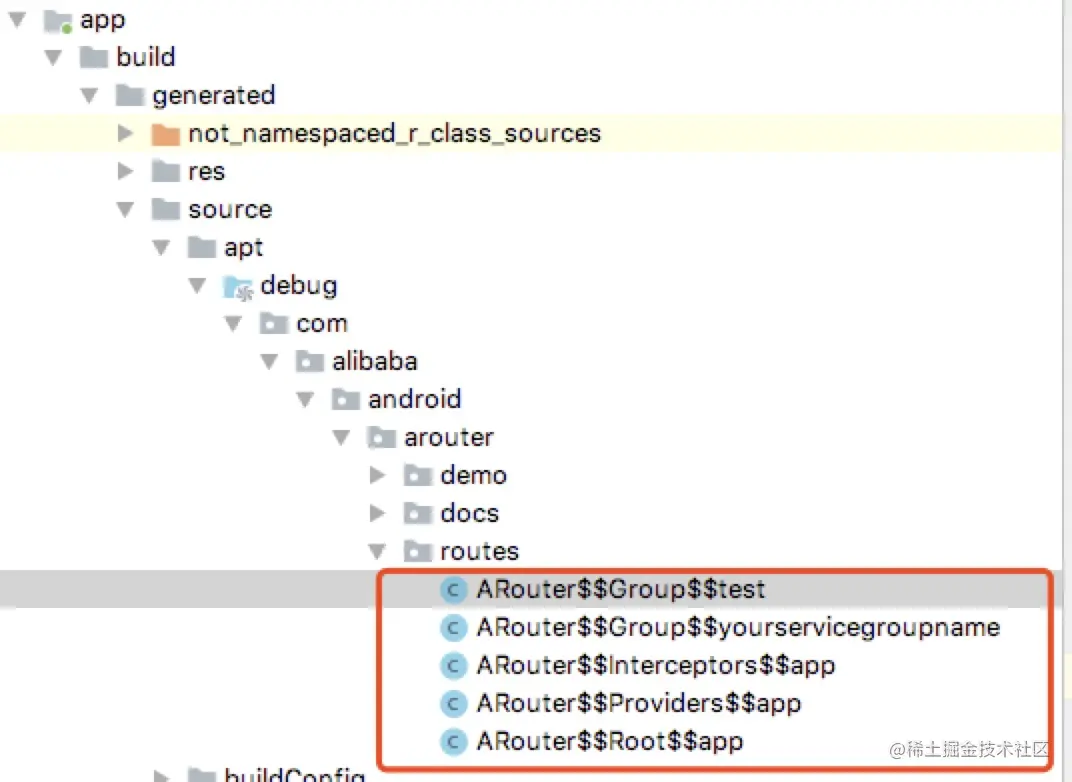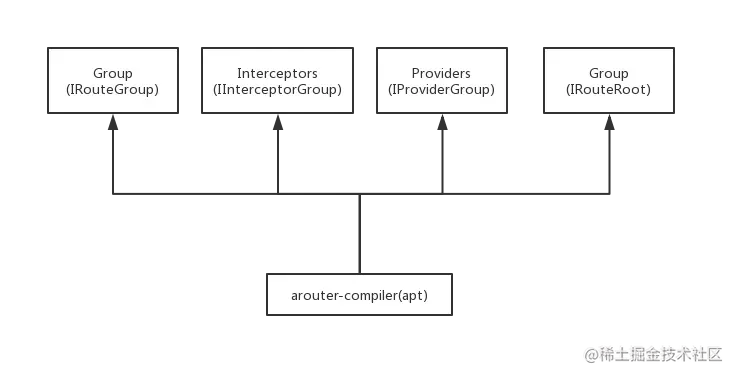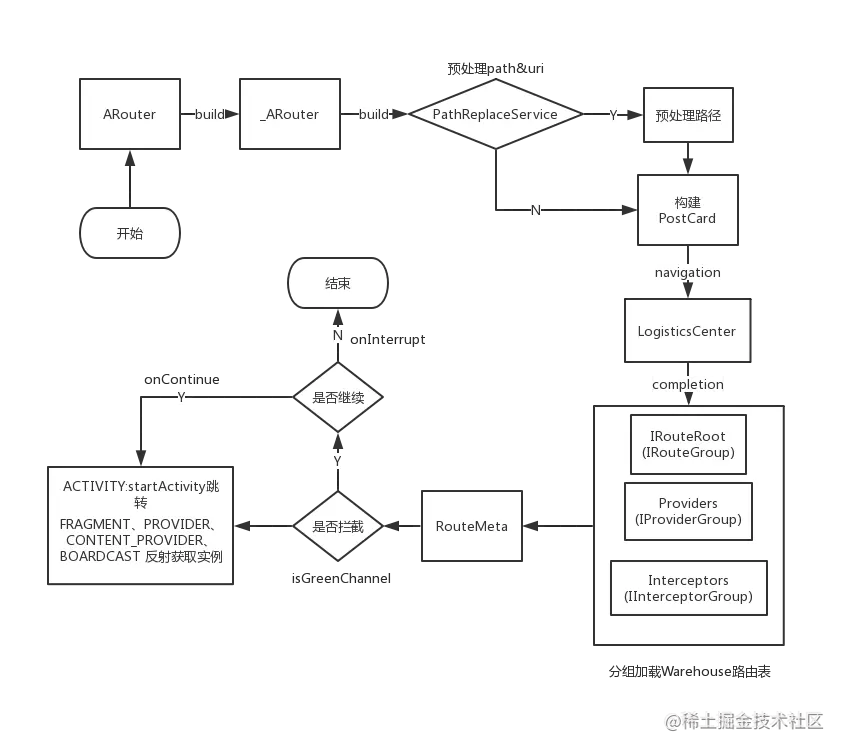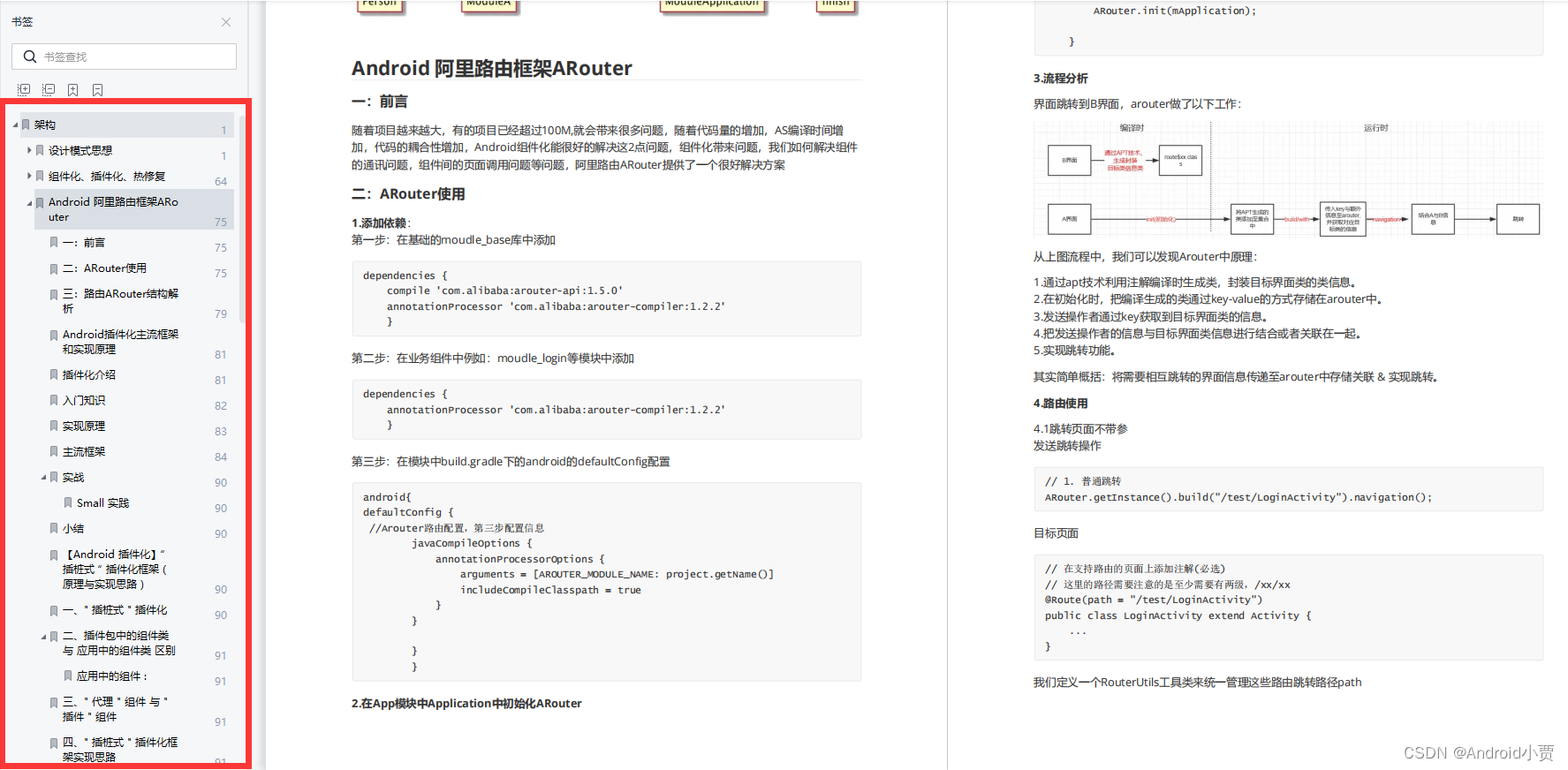您现在的位置是:首页 >技术交流 >Android 路由框架ARouter源码解析网站首页技术交流
Android 路由框架ARouter源码解析
作者:小马快跑
我们知道在使用ARouter时,需要在build.config里配置:
annotationProcessor 'com.alibaba:arouter-compiler:1.2.2'
并且知道annotationProcessor用来声明注解解析器,arouter-compiler用来解析ARouter中的各个注解并自动生成class类,那么我们就来看一下到底生成了哪些类:

其生成的5个索引文件有4大类(Group类有2个文件,按Group区分开了),他们都实现了ARouter中的接口:

至于他们都代表什么,我们后面一一分析。
ARouter初始化
在自定义Application中进行初始化:
// 尽可能早,推荐在Application中初始化
ARouter.init(Application.this);
点进去看一下:
//ARouter.java
public static void init(Application application) {
if (!hasInit) {
logger = _ARouter.logger;
_ARouter.logger.info(Consts.TAG, "ARouter init start.");
hasInit = _ARouter.init(application);
if (hasInit) {
_ARouter.afterInit();
}
_ARouter.logger.info(Consts.TAG, "ARouter init over.");
}
}
哦,ARouter又调用了_ARouter.init(application)去初始化,再点进去:
//_ARouter.java
private volatile static ThreadPoolExecutor executor = DefaultPoolExecutor.getInstance();
protected static synchronized boolean init(Application application) {
mContext = application;
LogisticsCenter.init(mContext, executor);
logger.info(Consts.TAG, "ARouter init success!");
hasInit = true;
mHandler = new Handler(Looper.getMainLooper());
return true;
}
哦,_ARouter在init初始化方法里除了初始化一些变量和一个handler,又调用了LogisticsCenter.init(mContext, executor), 其中executor是一个线程池, 继续跟到LogisticsCenter里去:
/**
* LogisticsCenter contains all of the map.
* 1. Creates instance when it is first used.
* 2. Handler Multi-Module relationship map(*)
* 3. Complex logic to solve duplicate group definition
*/
//LogisticsCenter.java
public synchronized static void init(Context context, ThreadPoolExecutor tpe) throws HandlerException {
Set<String> routerMap;
//1、遍历“com.alibaba.android.arouter.routes”路径下的类并把其加入到set中
if (ARouter.debuggable() || PackageUtils.isNewVersion(context)) {
// These class was generated by arouter-compiler.
routerMap = ClassUtils.getFileNameByPackageName(mContext, ROUTE_ROOT_PAKCAGE);
if (!routerMap.isEmpty()) {
context.getSharedPreferences(AROUTER_SP_CACHE_KEY, Context.MODE_PRIVATE).edit().putStringSet(AROUTER_SP_KEY_MAP, routerMap).apply();
}
// Save new version name when router map update finishes.
PackageUtils.updateVersion(context);
} else {
logger.info(TAG, "Load router map from cache.");
routerMap = new HashSet<>(context.getSharedPreferences(AROUTER_SP_CACHE_KEY, Context.MODE_PRIVATE).getStringSet(AROUTER_SP_KEY_MAP, new HashSet<String>()));
}
//2、遍历set,将root、group、provider分类并填充到Warehouse路由表中
for (String className : routerMap) {
if (className.startsWith(ROUTE_ROOT_PAKCAGE + DOT + SDK_NAME + SEPARATOR + SUFFIX_ROOT)) {
// This one of root elements, load root.
((IRouteRoot) (Class.forName(className).getConstructor().newInstance())).loadInto(Warehouse.groupsIndex);
} else if (className.startsWith(ROUTE_ROOT_PAKCAGE + DOT + SDK_NAME + SEPARATOR + SUFFIX_INTERCEPTORS)) {
// Load interceptorMeta
((IInterceptorGroup) (Class.forName(className).getConstructor().newInstance())).loadInto(Warehouse.interceptorsIndex);
} else if (className.startsWith(ROUTE_ROOT_PAKCAGE + DOT + SDK_NAME + SEPARATOR + SUFFIX_PROVIDERS)) {
// Load providerIndex
((IProviderGroup) (Class.forName(className).getConstructor().newInstance())).loadInto(Warehouse.providersIndex);
}
}
}
}
LogisticsCenter.init方法比较长,上面只保留了核心代码,ARouter优先使用arouter-auto-register插件去解析并填充Warehouse路由表,忽略这种方式。我们来看上面这种加载方式,PackageUtils.isNewVersion(context)中判断SharedPreferences(后面简称sp)里面是否有存储versionName及versionCode,如果没有或者他们有更新的时候,需要重新加载一次com.alibaba.android.arouter.routes这个路径下的类名并填充到Set中,否则直接从sp中取数据并赋值到Set中去。接着就开始遍历这个Set,并通过Class.forName(className)这种反射方式去实例化类并调用类中的loadInto方法将注解对应的索引信息添加到Warehouse路由表中。画个图来总结一下:

ARouter跳转
ARouter跳转时,直接使用ARouter.getInstance().build("xxx/xxx").navigation()即可完成跳转,那我们就来看一下源码,看看里面都做了什么,首先是build方法:
/**
* Build postcard by path and default group
*/
protected Postcard build(String path) {
if (TextUtils.isEmpty(path)) {
throw new HandlerException(Consts.TAG + "Parameter is invalid!");
} else {
PathReplaceService pService = navigation(PathReplaceService.class);
if (null != pService) {
path = pService.forString(path);
}
return build(path, extractGroup(path));
}
}
/**
* Build postcard by uri
*/
protected Postcard build(Uri uri) {
if (null == uri || TextUtils.isEmpty(uri.toString())) {
throw new HandlerException(Consts.TAG + "Parameter invalid!");
} else {
PathReplaceService pService = ARouter.getInstance().navigation(PathReplaceService.class);
if (null != pService) {
uri = pService.forUri(uri);
}
return new Postcard(uri.getPath(), extractGroup(uri.getPath()), uri, null);
}
}
/**
* Build postcard by path and group
*/
protected Postcard build(String path, String group) {
if (TextUtils.isEmpty(path) || TextUtils.isEmpty(group)) {
throw new HandlerException(Consts.TAG + "Parameter is invalid!");
} else {
PathReplaceService pService = ARouter.getInstance().navigation(PathReplaceService.class);
if (null != pService) {
path = pService.forString(path);
}
return new Postcard(path, group);
}
}
三个方法中都有,PathReplaceService pService = ARouter.getInstance().navigation(PathReplaceService.class); 那么这个PathReplaceService是干啥的,点进去看看:
/**
* Preprocess your path
*/
public interface PathReplaceService extends IProvider {
/**
* For normal path.
*
* @param path raw path
*/
String forString(String path);
/**
* For uri type.
*
* @param uri raw uri
*/
Uri forUri(Uri uri);
}
看它的介绍就知道了,原来这个类是用来预处理path和uri的,调用方需要实现PathReplaceService就可以做预处理,如果不实现,默认pService==null,那么直接走下面的去初始化Postcard实体类。
接着来看navigation方法,因为build方法返回的是PostCard类,所以调用的是PostCard类的navigation方法,经过一系列跳转,最终来到_ARouter.getInstance().navigation(mContext, postcard, requestCode, callback) :
protected Object navigation(final Context context, final Postcard postcard, final int requestCode, final NavigationCallback callback) {
try {
LogisticsCenter.completion(postcard);
} catch (NoRouteFoundException ex) {
logger.warning(Consts.TAG, ex.getMessage());
}
return null;
}
if (null != callback) {
callback.onFound(postcard);
}
if (!postcard.isGreenChannel()) {
// It must be run in async thread, maybe interceptor cost too mush time made ANR.
interceptorService.doInterceptions(postcard, new InterceptorCallback() {
@Override
public void onContinue(Postcard postcard) {
_navigation(context, postcard, requestCode, callback);
}
@Override
public void onInterrupt(Throwable exception) {
if (null != callback) {
callback.onInterrupt(postcard);
}
}
});
} else {
return _navigation(context, postcard, requestCode, callback);
}
return null;
}
去除了部分无关代码,只保留了核心代码,首先调用了LogisticsCenter.completion方法,我们追进去看看:
//LogisticsCenter.java
/**
* Completion the postcard by route metas
*
* @param postcard Incomplete postcard, should complete by this method.
*/
public synchronized static void completion(Postcard postcard) {
RouteMeta routeMeta = Warehouse.routes.get(postcard.getPath());
if (null == routeMeta) {
// Maybe its does't exist, or didn't load.
Class<? extends IRouteGroup> groupMeta = Warehouse.groupsIndex.get(postcard.getGroup()); // Load route meta.
if (null == groupMeta) {
throw new NoRouteFoundException(TAG + "There is no route match the path [" + postcard.getPath() + "], in group [" + postcard.getGroup() + "]");
} else {
// Load route and cache it into memory, then delete from metas.
try {
IRouteGroup iGroupInstance = groupMeta.getConstructor().newInstance();
iGroupInstance.loadInto(Warehouse.routes);
Warehouse.groupsIndex.remove(postcard.getGroup());
} catch (Exception e) {
throw new HandlerException(TAG + "Fatal exception when loading group meta. [" + e.getMessage() + "]");
}
completion(postcard); // Reload
}
} else {
postcard.setDestination(routeMeta.getDestination());
postcard.setType(routeMeta.getType());
postcard.setPriority(routeMeta.getPriority());
postcard.setExtra(routeMeta.getExtra());
Uri rawUri = postcard.getUri();
if (null != rawUri) { // Try to set params into bundle.
Map<String, String> resultMap = TextUtils.splitQueryParameters(rawUri);
Map<String, Integer> paramsType = routeMeta.getParamsType();
if (MapUtils.isNotEmpty(paramsType)) {
// Set value by its type, just for params which annotation by @Param
for (Map.Entry<String, Integer> params : paramsType.entrySet()) {
setValue(postcard,
params.getValue(),
params.getKey(),
resultMap.get(params.getKey()));
}
// Save params name which need auto inject.
postcard.getExtras().putStringArray(ARouter.AUTO_INJECT, paramsType.keySet().toArray(new String[]{}));
}
// Save raw uri
postcard.withString(ARouter.RAW_URI, rawUri.toString());
}
switch (routeMeta.getType()) {
case PROVIDER: // if the route is provider, should find its instance
// Its provider, so it must implement IProvider
Class<? extends IProvider> providerMeta = (Class<? extends IProvider>) routeMeta.getDestination();
IProvider instance = Warehouse.providers.get(providerMeta);
if (null == instance) { // There's no instance of this provider
IProvider provider;
try {
provider = providerMeta.getConstructor().newInstance();
provider.init(mContext);
Warehouse.providers.put(providerMeta, provider);
instance = provider;
} catch (Exception e) {
throw new HandlerException("Init provider failed! " + e.getMessage());
}
}
postcard.setProvider(instance);
postcard.greenChannel(); // Provider should skip all of interceptors
break;
case FRAGMENT:
postcard.greenChannel(); // Fragment needn't interceptors
default:
break;
}
}
}
这个类很长,但是逻辑还是很清晰的:首先从Warehouse路由表的routes中获取RouteMeta,但是第一次获取的时候为空(因为init时只填充了Warehouse路由表的groupsIndex、interceptorsIndex、providersIndex,还记得吗?),接着从Warehouse.groupsIndex中根据group的名字找到对应的group索引,并将生成的索引类的map数据加载到Warehouse.routes中,然后把Warehouse.groupsIndex中对应的group删除掉,以免重复加载数据,然后调用了completion(postcard)进行重新加载。此时Warehouse.routes已经不为空,根据path获取对应的RouteMeta,就会走到else逻辑中,先是对PostCard设置了一堆属性,最后对IProvider的子类进行了初始化并加载到Warehouse.providers中,同时也设置到PostCard中,并给PROVIDER和FRAGMENT设置了绿色通道(不会被拦截)。总结一下:主要逻辑就是通过Warehouse.groupsIndex找到对应的group并进行加载,实现了分组加载路由表。
我们继续回到navigation方法中往下走,首先通过postcard.isGreenChannel()判断是否会拦截,如果拦截,就会走interceptorService的逻辑(interceptorService是在afeterInit中初始化的),否则就走到了_navigation逻辑中,那么来看_navigation方法:
private Object _navigation(final Context context, final Postcard postcard, final int requestCode, final NavigationCallback callback) {
final Context currentContext = null == context ? mContext : context;
switch (postcard.getType()) {
case ACTIVITY:
// Build intent
final Intent intent = new Intent(currentContext, postcard.getDestination());
intent.putExtras(postcard.getExtras());
// Set flags.
int flags = postcard.getFlags();
if (-1 != flags) {
intent.setFlags(flags);
} else if (!(currentContext instanceof Activity)) { // Non activity, need less one flag.
intent.setFlags(Intent.FLAG_ACTIVITY_NEW_TASK);
}
// Set Actions
String action = postcard.getAction();
if (!TextUtils.isEmpty(action)) {
intent.setAction(action);
}
// Navigation in main looper.
runInMainThread(new Runnable() {
@Override
public void run() {
startActivity(requestCode, currentContext, intent, postcard, callback);
}
});
break;
case PROVIDER:
return postcard.getProvider();
case BOARDCAST:
case CONTENT_PROVIDER:
case FRAGMENT:
Class fragmentMeta = postcard.getDestination();
try {
Object instance = fragmentMeta.getConstructor().newInstance();
if (instance instanceof Fragment) {
((Fragment) instance).setArguments(postcard.getExtras());
} else if (instance instanceof android.support.v4.app.Fragment) {
((android.support.v4.app.Fragment) instance).setArguments(postcard.getExtras());
}
return instance;
} catch (Exception ex) {
logger.error(Consts.TAG, "Fetch fragment instance error, " + TextUtils.formatStackTrace(ex.getStackTrace()));
}
case METHOD:
case SERVICE:
default:
return null;
}
return null;
}
private void startActivity(int requestCode, Context currentContext, Intent intent, Postcard postcard, NavigationCallback callback) {
if (requestCode >= 0) {
// Need start for result
if (currentContext instanceof Activity) {
ActivityCompat.startActivityForResult((Activity) currentContext, intent, requestCode, postcard.getOptionsBundle());
}
} else {
ActivityCompat.startActivity(currentContext, intent, postcard.getOptionsBundle());
}
if ((-1 != postcard.getEnterAnim() && -1 != postcard.getExitAnim()) && currentContext instanceof Activity) { // Old version.
((Activity) currentContext).overridePendingTransition(postcard.getEnterAnim(), postcard.getExitAnim());
}
if (null != callback) { // Navigation over.
callback.onArrival(postcard);
}
}
哦,原来ARouter跳转Activity最终也是用原生的Intent实现的,如果navigation()不传入context,则使用初始化时Application作为context,如果是FRAGMENT、PROVIDER、CONTENT_PROVIDER、BOARDCAST,通过反射方式初始化并返回即可。
尝试画个图来总结一下navigation:

嗯,到这里ARouter内部的主要流程就分析完了~
ARouter跳转原理:ARouter路由跳转本质上也是通过原生的startActiviy及startActivityForResult来实现的,只不过ARouter通过APT形式将编译期通过解析注解生成的索引加载到Warehouse路由表中,从而制造跳转规则。并且可以在跳转之前设置拦截或过滤。
下面整理了《Android 架构学习手册》学习笔记,根据自己学习中所做的一些笔录来整的,主要也是方便后续好复习翻阅,省掉在去网上查找的时间,以免在度踩坑,如果大家有需要的可以直接 通过点击此处↓↓↓ 进行参考学习:https://qr21.cn/CaZQLo?BIZ=ECOMMERCE
Android 架构学习手册







 U8W/U8W-Mini使用与常见问题解决
U8W/U8W-Mini使用与常见问题解决 QT多线程的5种用法,通过使用线程解决UI主界面的耗时操作代码,防止界面卡死。...
QT多线程的5种用法,通过使用线程解决UI主界面的耗时操作代码,防止界面卡死。... stm32使用HAL库配置串口中断收发数据(保姆级教程)
stm32使用HAL库配置串口中断收发数据(保姆级教程) 分享几个国内免费的ChatGPT镜像网址(亲测有效)
分享几个国内免费的ChatGPT镜像网址(亲测有效) Allegro16.6差分等长设置及走线总结
Allegro16.6差分等长设置及走线总结